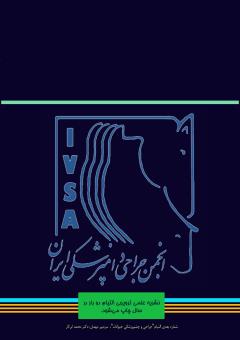An overview of colic in horses
Subject Areas :Hanieh Fatemi 1 , Hesamodin Torghabeh 2 , Alireza Kavehaski 3
1 -
2 -
3 -
Keywords: Colic, Horse, Surgery,
Abstract :
Colic or abdominal pain has long been one of the most important and challenging diseases that veterinarians in equine medicine have always dealt with. In colic, the choice of treatment method between medical and surgical has always been discussed. According to the findings of physical examinations such as pain, cardiovascular system, anal examination and other clinical and laboratory methods, the type of treatment method is selected and if necessary, by using appropriate techniques in cases that require surgery, the patient recovers. Finally, attention to the care required after this period is also one of the effective measures in the treatment of colic in horses.
1. Curtis L, Burford JH, Thomas JS, Curran ML, Bayes TC, England GC, Freeman SL. Prospective study of the primary evaluation of 1016 horses with clinical signs of abdominal pain by veterinary practitioners, and the differentiation of critical and non-critical cases. Acta Vet Scand 2015; 57 (1): 69.
2. Curtis L, Burford JH, England GC, Freeman SL. Risk factors for acute abdominal pain (colic) in the adult horse: A scoping review of risk factors, and a systematic review of the effect of management-related changes. PloS one 2019; 14 (7): e0219307.
3. Singer ER, Smith MA. Examination of the horse with colic: is it medical or surgical? Equine Vet Educ 2002; 14 (2): 87-96.
4. Moore JN. Medical versus Surgical treatment of horses with colic. Current Therapy in equine Medicine IV. Philadelphia: WB Saunders Co. 1998: 179-181.
5. Steckel RR. Diagnosis and management of acute abdominal pain (colic). Equine surgery 1992: 348-360.
6. White NA, Edwards GB. Handbook of equine colic. Butterworth-Heinemann; 1999.
7. Reeves MJ, Curtis CR, Salman MD, Stashak TS, Reif JS. Multivariable prediction model for the need for surgery in horses with colic. Am J Vet Med Res 1991; 52 (11): 1903.
8. White NA. Examination and diagnosis of the acute abdomen. The equine acute abdomen. 1990: 102-142.
9. Kopf N. Rectal examination of the colic patient. Current therapy in equine medicine. 1997; 4: 170-174.
10. Mueller PE, Moore JN. Rectal examination of horses with acute abdominal pain. Compendium on Continuing Education for the Practicing Veterinarian 2000; 22 (6): 606-615.
11. Freeman DE. Duodenitis‐proximal jejunitis. Equine Vet Educ 2000; 12 (6):322-332.
12. Freden GO, Provost PJ, Rand WM. Reliability of using results of abdominal fluid analysis to determine treatment and predict lesion type and outcome for horses with colic: 218 cases (1991-1994). J Am Vet Med Assoc 1998; 213 (7): 1012.
13. Williamson L. Diagnostic procedures for evaluating equine colic. Veterinary medicine (USA). 1987.
14. Bach LG, RICKETTS SW. Paracentesis as an aid to the diagnosis of abdominal disease in the horse. Equine Vet J 1974; 6 (3): 116-121.
15. Edwards B. Differential diagnosis of gastric dilation in the horse. In Pract 1993; 15 (3): 111-117.
16. White NA, Moore JN, Mair TS. Equine acute abdomen. CRC Press; 2009.
17. Sullins KE, White NA, Lundin CS, Dabareiner R, Gaulin G. Prevention of ischaemia‐induced small intestinal adhesions in foals. Equine Vet J 2004; 36 (5): 370-375.
18. Hughes KJ, Dowling BA, Matthews SA, AJ D. Results of surgical treatment of colic in miniature breed horses: 11 cases. Aust Vet J 2003; 81 (5): 260-264.
19. Haupt JL, McAndrews AG, Chaney KP, Labbe KA, Holcombe SJ. Surgical treatment of colic in the miniature horse: a retrospective study of 57 cases (1993–2006). Equine Vet J 2008; 40 (4): 364-367.
20. Auer JA, Stick JA. Equine Surgery. Elsevier Health Sciences; 2018.
21. Southwood L, Wilkins PA, editors. Equine emergency and critical care medicine. CRC Press; 2014.


